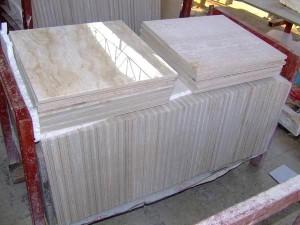
02 Jan The Timeless Beauty of Marble Cladding
From ancient Mesopotamian and Egyptian cultures to London’s Marble Arch; from Rome’s Pantheon to the Taj Mahal in Agra; from the Parthenon in Athens to Stow House’s Marble Room (Buckinghamshire) and the exterior of Westminster Cathedral, marble cladding has been used to add timeless beauty to the interior and exterior of buildings around the world for centuries. The question is, just what is it that makes this particular stone so popular?
About Marble
 A metamorphic rock predominantly consisting of an interlocking mosaic of recrystallised protolith (carbonate minerals like dolomite and limestone), Marble comes in an array of colours and patterns.
A metamorphic rock predominantly consisting of an interlocking mosaic of recrystallised protolith (carbonate minerals like dolomite and limestone), Marble comes in an array of colours and patterns.
These colours and patterns are the result of varying impurities (i.e. chert, iron oxides, sand, silt, clay or, as is the case in green marble, serpentine, which is caused by silica impurities within magnesium-rich dolomite or limestone) that were originally present within the protolith in the shape of layers or grains having been mobilised and recrystallised by the metamorphism’s intense heat and pressure.
The Timeless Beauty of Marble Cladding
Marble’s hardness (3, Moh’s hardness scale) and translucence make it a popular, easy to carve material for ornamental objects and sculptures. Its popularity as a building material is because marble readily accepts polishing to a high lustre and can be easily cut for use as cladding on walls, floor tiles or columns; stair treads, window sills, facing stones and more. As the marble-clad buildings and rooms of old testify, beautifully patterned, shiny and translucent marble brings timeless beauty to the environments within which it is used.
The Disadvantages of Marble Cladding
There are, however, some disadvantages to the use of natural marble in architectural projects:
Weight – Typically sold in the shape of tiles ranging in size up to 600 x 600 mm with thicknesses of between 10 and 15 mm, natural marble is comparatively heavy. What’s more, as tile size increases, so does the materials thickness, which can go up to as much as 20 – 30 mm. This, of course, significantly increases its weight. Limitations on building’s load capacity can subsequently prevent the use of this material over larger areas.
Expense – Marble, like other natural stones, is comparatively expensive. In addition, larger panels needed for wall cladding require mechanical fixings, which further add to an installation’s overall cost.
Risk of Damage – The inherent fragility and lack of hardness of marble also means it is highly susceptible to damage (i.e. cracking, chipping or breaking) during transport, as well as during and after installation.
Consistency of Colour/Pattern – Use of natural marble makes it fairly difficult to achieve consistency in pattern and colour/tone over larger areas.
Environment – A cubic-metre of raw marble can produce solid panels sufficient to cover approximately 45 m2. The larger an area to be covered is, the more raw stone is required and the more natural resources are depleted – which is, of course, far from helpful to the environment.
An Alternative Solution
The cost, weight and environmental concerns of using marble often prevents use of this incredibly beautiful material. There is, however, a more cost-effective, environmentally friendly and much lighter alternative: Lightweight Marble Cladding.
Lightweight marble panels consist of thin sheets of natural marble veneer that have been bonded to a choice of backing panel (learn more). Weighing just 16 kg/m2 irrespective of size, these panels can be:
- Supplied in standard sheet sizes of 2400 x 2400 mm or cut to specific sizes
- Applied to walls (any solid surfaces or substrates) by use of inexpensive adhesives, interlocking channels or concealed screws without the need for expensive, time-consuming preparatory measures
- Used to cover large areas without risk of exceeding load restrictions
Provided with increased overall strength, flexibility & impact resistance by the backing process, Lightweight Marble is also less likely to incur damages during or after transport/installation, warp or suffer the effects of corrosion, water/moisture penetration or chemicals.
Producing enough panels to clad an area of as much as 135 m2 from a single cubic-metre of raw marble, this process also promotes conservation of the environment by reducing exploitation of resources, as well as reducing the cost of stone per square-metre and making it possible to achieve greater consistency in texture and tone over large areas.
Get in Touch
Are you ready to introduce the natural, timeless beauty of Lightweight Marble Cladding into your environment? Give us a call on 0203 292 0616 today.



